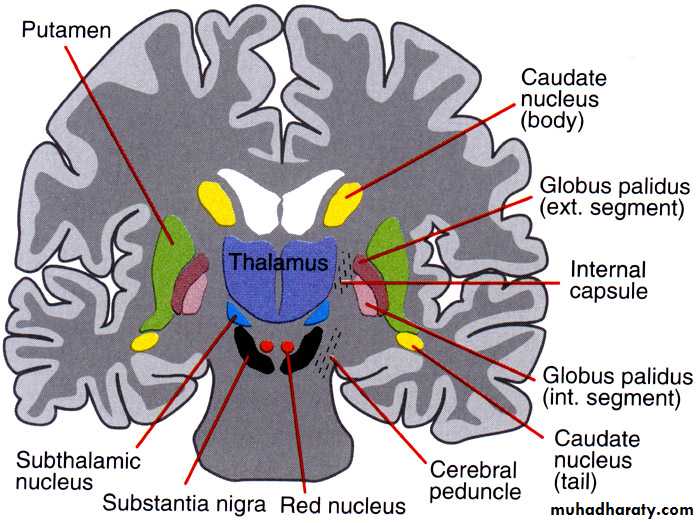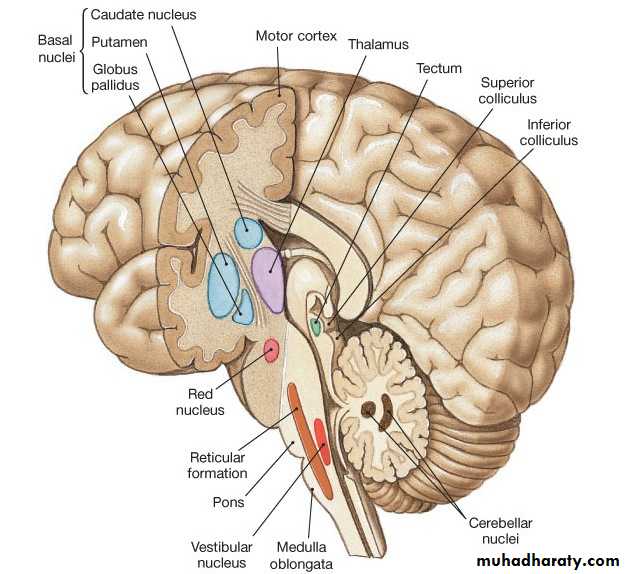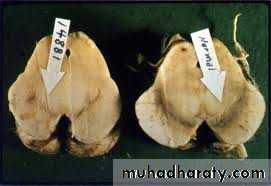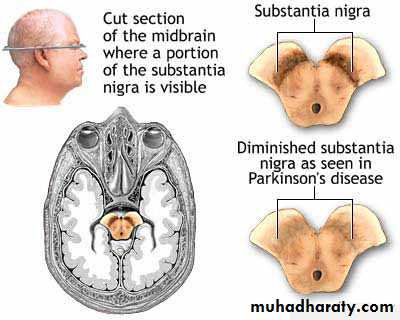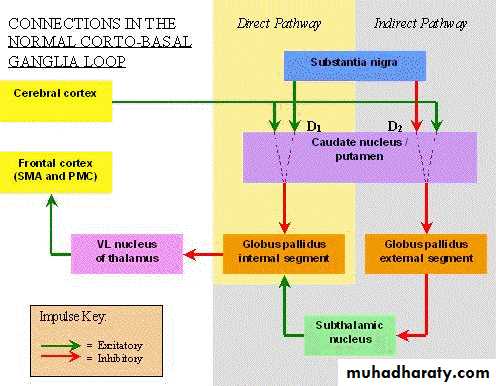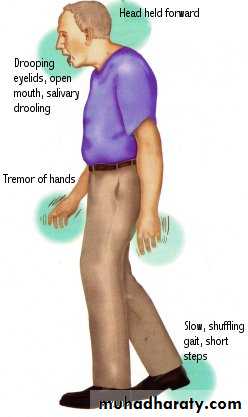MOVEMENT DISORDERS
ANATOMYThe basal ganglia refer to
1 - Caudate nucleus .
2 - Putamen .
3 - Globus pallidus
4 - Subthalamic nucleus .
5 - Substantia nigra .
Putamen + globus pallidus = Lentiform ( Lenticular Nucleus ).
Caudate N. + Lenticular N. = Corpus StraitumPutamen + Caudate N. = Straium or Neostraitum .
Substatia Nigra composed of two parts
1- Dorsal compact part containing packed pigmented neurons that produce dopamine .2 – Reticular part contain more loosely packed neuron which non pigmented and near the cerebral peduncle .
Compact part of the Substantia Nigra
The pigmented neurons in this part use dopamine as their neurotransmitter .They project in a precisely organized topographic fashion to the caudate nucleus and putmen .The dopaminergic endings in the striatum ultimately modulate the output from the globus pallidus so It excites the direct pathway and inhibits the indirect pathway thus , it facilitates movement .
FUNCTION OF THE BASAL GANGLIA
1 - Regulation of the voluntary motor activity .2 - Control of the muscle tones .
3- Maintenance emotional and associated movement .Disturbance in basal ganglia functions lead to
1- Disturbances in the of motor activity resulting in disturbances of movements which may be of two main typesA - The hypokinesias or akinesia ; in which the poverty of movements is predominant as in Parkinson's disease .
B - The dyskinesias in which there are a variety of excessive involuntary movements like chorea ,athetosis , dystonea and hemibalismus .
2- Disturbance in the normal muscle tone resulting in hypertonia (rigidity ) .
3- Disturbance in maintenance of emotional and associated movement like :- Mask face
- Infrequent blinking
- Loss of swinging of the arm during walking
Parkinson's disease
Parkinson's disease is a neurodegenerative condition occurs when neurons in the substantia nigra in the midbrain die or become impaired .
As a result the patients present with different combinations of
1- Tremor
2- Rigidity ( increased tone of the muscles ).
3- Bradykinesia ( slowness of movement ).
4- Loss of postural reflexes .
Parkinson’s Disease ( PD ) the annual incidence is about 0.2/1000 and prevalence of 1.5 /1000 in UK.
Affects 1–1.5 million people in the USA .
Average age of onset is 60 years old .
About 10 % under 45 years at presentation.
Rare in people younger than 30 , but can occur .
PD is somewhat more prevalent among Caucasians and equal in male and female .
Possible causes of Parkinson's Disease
The causes of Parkinson's disease in the majority not known , however some theories include :1- Genetic factors include mutations in the alpha – synuclein and parkin gene and in mitochondrial DNA .
11- Free radicals
Neuropathology of Parkinson's Disease
Characterized by neuronal loss and neuromelanin loss in the SNc, as well as accumulation of a protein called alpha-synuclein into inclusions called lewy bodies in the same structure.
PD also involves loss of cells in other pigmented catecholaminergic nuclei, including the ventral tegmental area, locus caeruleus and the serotonergic raphe nucleus.
CLINICAL FEATURES OF Parkinson’s Disease Parkinson´s disease has an insidious onset, meaning it is slow to progress.
Early symptoms include :
• 1- Difficulty with tasks that require fine control, such as buttoning a shirt
• 2- Minor shakiness
• 3- Soft rapid indistinct speech
• 4- Small handwriting
• 5- Minor mental or emotional problems(masked face)
• 6- Slow walking or decreased arm swing when walking
Last symptoms
As the disease progresses , patients tend to exhibit the four primary symptoms .1 - Tremor
2 - Rigidity
3 - Bradykinesia
4 - Postural instability
Resting tremor ( 4-6 HZ ) characteristically involving the hands in a " pill-rolling" movement that diminishes during voluntary movement and increases during emotional stress , it may affect arm , leg , feet , jaw , tongue .
Rigidity caused by increased tone in all muscles , though the strength is nearly normal and reflexes are not particularly affected .
The rigidity in Parkinson's disease may be :
uniform throughout a range of movement imposed by the examiner ( plastic or lead – pipe rigidity )or be interrupted by a series of brief relaxations ( cog – wheel rigidity )
Bradykinesia , slowness of movements and hypokinesia , or few movement is shown by decreased blinking , expressionless face (MASK FACE) and absence of arm movements associated with walking .
Difficulty in initiating movement , poor handwriting , inability to button clothes and difficulty in rising from low chairs .
The muscle in face may also be slow , giving a mask-like expression with reduced eye-blinking & staring
Postural instability
Decline of postural reflexes , causing a loss of balance. Posture is stooped and knees are flexed when walking causing patient to be unsteady in walking or turning and falls may occur .Gait disorders
1- Slow to start walking .
2- Slow shortened steps (shuffling) .
3- Rapid, shortened steps (festinating)
4- Reduced arm swinging .
5- Impaired balance on turning .
Other symptoms
Patients often experience a number of other symptoms not related to the four primary symptoms .Depression
Emotional changes
Difficulty swallowing and chewing
Urinary problems
Excessive sweating
Sleep problems
Parkinsonism
Parkinsonism is the name used to describe a condition with the four primary symptoms of Parkinson's disease in addition to other symptomsParkinsonism syndromes include
Multiple system atrophies
Progressive supranuclear palsy
Cortico – basal – ganglionic degeneration
Striaonigral degeneration
Shy-drager syndrome.
Oilvopontocerebellar degeneration
Drug-induced
Toxins : manganese , carbon monoxide , cyanide , methanol , methyl-phenyl-tetrahydropyradine (MPTP) in young drug user
Stroke
Tumor
Trauma
Treatment
There is no cure for Parkinson's disease , but there are many medications to help alleviate the symptoms . the most used medication is levodopa or L-dopa .A-levodopa ( L dopa ; Dopamine precursor )
Parkinson's disease due to a lack of dopamine in the substantia nigra in the brain .
Dopamine can't cross the blood-brain barrier , levodopa can , after levodopa crosses the blood-brain barrier , converted to dopamine and then can be used by the brain
The addition of carbidopa which inhibit extracerebal decarboxylalation of levodopa to dopamine in the liver thus reduce the side effect due to peripheral action of dopamine and increase the cerebral level of levodopa.
Carbi-dopa dose not cross the blood brain barrier.
Sinemet : it is a combination of both Levodopa + carbidopa ( dopa decarboxylase inhibitor ).
Preparations ; 100 mg L-dopa + 10 mg carbidopa
100 + 25200 + 25
250 + 25
Modapar ( levodopa +benserazide )
Parcopa is an orally disintegrating carbidopa/levodopa tablet that dissolves within seconds after being placed on the tongue
Side Effects of L-dopa
Early :Nausea and vomiting
Hypotension
Dyskinesias
Restlessness
Cardiac arrhythmias
Late :
late dyskinesias and behavior S/E , can be treated with either clozapine (require WBC count ) , Olanzepine or risperidol .Wearing-off effect ( end dose effect ).
On-off phenomenon .
Contraindications :
Narrow angle glaucoma .
Psychotic illness .
Avoided in patient receiving MAO A inhibitors .
Should be used with care in patient with suspected malignant melanomas .
Dopamine Agonist
DAs are directly stimulate dopamine receptors in the striatum . they effective as monotherapy in early Parkinson's disease to improve motor symptoms and as adjuncts to levodopa in patient with motor fluctuation to reduce off time
Apomorphine SC infusion or direct injection
Pramipexole
Ropinirole non-ergot
Bromocriptine ergot
Pergolide
COMT (Catecholamine -O- Methyltranseverase) Inhibitors are used to extend the action of levodopa include
Entacapone 200mg three times/day and tolcapone 100mg
Stalevo ; (L-dopa + carbidopa + entacapone )
They are used to :
Reduce the dose requirement of sinemet .
Reduce the response fluctuations to sinemet.
Lead to more sustained plasma level of L-dopa.
Improve transport into the blood and across blood– brain barrier
Antcholinergic Drugs
Benztrroppine 1 – 4 mg/day in divided dosesTrihexyphenodyl 1 - 8 mg/day in divided doses
They useful for tremor and rigidity .
Amantadine 200 mg/day in divided doses
MAO B inhibitors :Selegiline ( eldepryl ) selective irreversible MAO-B inhibitor that is beneficial as an adjunct to levodopa to reduce motor fluctuations also it has modest symptomatic benefit as monotherapy in early PD
Rasagiline (Azilect) similar to selegline but appear to have greater symptomatic efficacy
Surgical treatment
1. pallidotomy2. Thalamotomy
3. Deep Brain stimulation
4. Fetal SN transplanted to the caudate nucleus.

